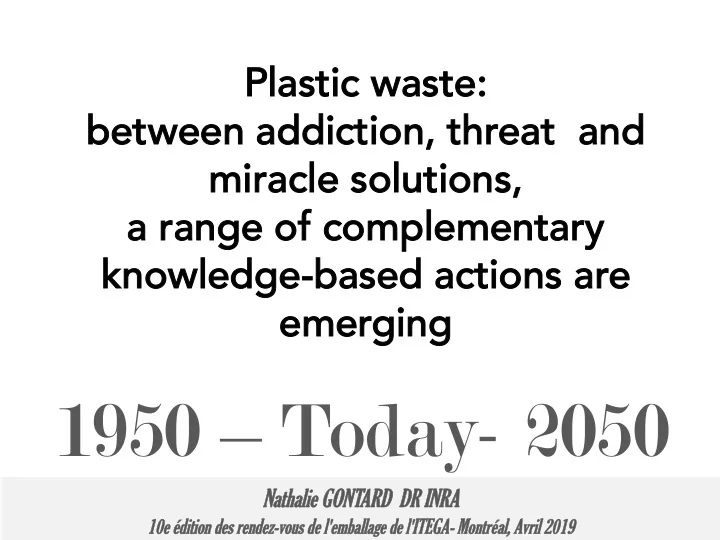

Plastic waste Plastic waste: : between between addiction, addiction, thr threat eat and and miracle solutions, miracle solutions, a range of a range of complementary complementary knowledge-based knowledge-based actions ar actions are e emer emerging ging 1950 – Today- 2050 Nathalie GONTARD RD DR R INRA RA 10 10e e édi édition on d des s re rendez-vous d de l' l'emba mballa llage d de l' l'ITEG ITEGA- Mo Montréal, Av Avril 2 201 019
1950 - Today
Nathalie GONTARD Emission + accumulation Global warming GHG Energy Fertilizer Plastic Major contamination Fine Particles Safety Well Being “What is the use of a fine house if you haven't got a tolerable planet to put it on.” Thoreau (1817-1862) Food
Petrochemical plastic
Plastic production
Key plastics dates 1953 PE and PP synthesized in Germany and Italy 1963 Nobel prize for catalyzers of plastic polymerization 1977 PET enters the market
Plastics become key actors of food consumption Processing, storage, transport, marketing, consumption.. Agriculture Consummer
Plastics are replacing vegetal leaves as food packaging in Africa, South America & Asia Vegetal leaves are active, intelligent, bio-sourced and biodegradable
Plastics 1950-2015 7800 Mt. total resins & fibers manufactured (3900 in the last 13 years) 6300 Mt plastic waste (12% incinerated , 9%recycled / 1% recycled > once) 4900 Mt (60% of plastics produced) in landfills and environment .
Today Ø 60 kg plastic/pers/year in average (>100 kg plastic/pers/year in the richest countries Ø 50 years old: you have produced 3 tons of plastic waste that will last 2 or 3 times longer than you, heritage to your children, grand children and beyond Ø 15 tons of plastics waste is available for you only in your environment whether you would be able to recycle
Plastic = linear system Resources regeneration time >>> human consumption time scale = accumulation Degradation TIME SCALE Millions years Regeneration INPUTS Raw materials
Food (40%) and agriculture (5%) represent the largest plastic consumption sector and >75% of uncollectable and dispersed plastic in our environment Ishigaki Island, Hokinawa, Japan, march 2018.
Where we are now - Today Environmental accumulation of persistent oil-sourced wastes CO 2 Biodegradation Fertilizer ε Resources Production Usage Waste Incineration (14%) Food crops Organic Bio-mass Food Food - food Petro-based Landfill (40%) Oil (fossil) Persistent Packaging Packaging Plastic Leakage (32%) Closed–loop Recycling (PET) = 2% Accumulation = 72% Open–loop Recycling = 8 % Global flow of food & packaging
Plastic = linear system Resources regeneration time >>>>>> human consumption time scale = accumulation Plastic degradation & diffusion It takes between 100 and 200 years to be INPUTS degraded into micro and nano-particles Raw materials Plastic micro-particules were detected in tap water, honey, seafood & many foods Nano-particles have the ability to cross organs barriers, accumulate and lead to dysfunctions.
Where we are planning to go - 2030 Recycling and bio-sourced efforts CO 2 Biodegradation Fertilizer ε Resources Production Usage Waste Incineration Food crops Organic Bio-mass Food Food - food Landfill (lower %) Oil (fossil) Persistent Petro-based Packaging Packaging Plastic Collecting Leakage (lower %) Re-use Sorting Closed–loop Recycling Open–loop Recycling (higher %) Global flow of food & packaging
What about recycling? 12% open loop recycling Process to produce another good that is not recyclable anymore = down cycling delayed waste accumulation OUPUTS Waste Accumulation PET fibers INPUTS Raw Virgin PET Materials Exhaustion
2050
Where we need to go - 2050 Bio-waste up-cycling efforts toward a circular bio-economy Composting Nutrients Resources Production Usage Waste Organic Bio-mass Food crops Food Food - Food 0 landfill 0 leakage - Biopackaging Bio-waste Oil (fossil) Packaging Packaging ε incineration Persistent plastic Petro-based Raw materials ε Re-use Closed–loop Recycling Fertilizers Biogas Up-cycling (bio-conversion, anaerobic digestion) Global flow of food & packaging
Closed loop system : rapid enough regeneration for an unlimited number of times Theoretically Bio-Economy is ∞ circular as all biological resources can be regenerated endlessly INPUTS Unless consumption rate > regeneration time
Nathalie GONTARD Emission + accumulation Global warming GHG Energy Fertilizer Plastic Major contamination Fine Particles Safety Well Being “What is the use of a fine house if you haven't got a tolerable planet to put it on.” Thoreau (1817-1862) Food PHA is bio 3 PHA Residues Bio-sourcé NA Bio-residues refinery 50% by weight Bio-produit Agricultural & urban Bio-dégradable Bio-energy & fertilizers Biodegradation Photosynthesis
INRA coordinates, and participates to, European initiatives around PHA 2025 2020 Pack4Fresh 2015 2010 2005
Euro-Chinese NoAW H2020 : agricultural residue refinery centred around AD and PHA production Microbial electrolysis ANAEROBIC DIGESTION Biomethane Biogas Pre-treatments (winery residues, manure, straw etc. ) cells Mesophilic 1 step biohythane AD digestate Local agro-wastes Thermophilic 2 steps Syngas Thermal / bioconvers° VFA-rich liquid effluent Bio-oil Bioethanol Biochar Enzymatic, physical & chemical deconstruct° Bi-functionalizat° Building blocks Photo-conversion & Bio-polymers Microbial-convers° Lignocell fillers Functionalisation Composites Mat. Polymerisation Formulation Feedstock - ressource Others chemicals Structuration Full-scale benchmark Conventional end-products Pilot-scale emerging advances Lab-scale novel processes Innovative end-products
PHA production from urban organic waste = Towards integrated processes mauro.majone@uniroma1.it Web site: www.resurbis.eu
Composting Nutrients Modified Atmosphere 0 landfill Packaging 0 leakage Up-cycling (bio-conversion, anaerobic digestion) Tailored properties Naturally biodegradable Non food renewable resources The Next Generation of plastic substitute is an eco-efficient safe material for ◉ its source ◉ its usage benefit & safety ◉ its end of life 25
GLOPACK The packaging sustainability indicator A+ Raw material B origin A B Food losses A+ C reduction D Material end B E of life 26
Thank you for your attention
Recommend
More recommend